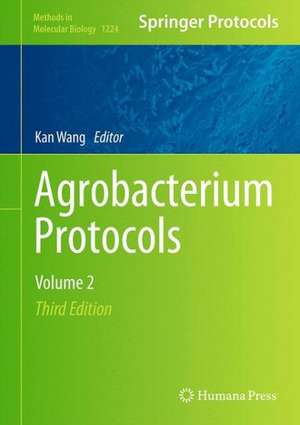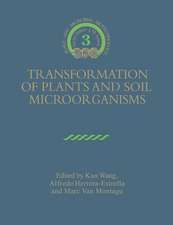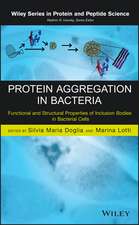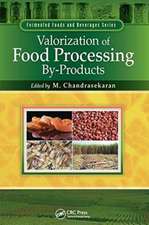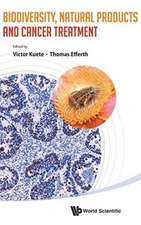Agrobacterium Protocols: Volume 2: Methods in Molecular Biology, cartea 1224
Editat de Kan Wangen Limba Engleză Hardback – 22 noi 2014
Volume 2 contains 29 chapters with updated techniques for industrial plants, root plants, nuts and fruits, tropic plants, and other important plant species. Written in the highly successful Methods in Molecular Biology series format, chapters include introductions to their respective topics, lists of the necessary materials and reagents, step-by-step, readily reproducible laboratory protocols, and tips on troubleshooting and avoiding known pitfalls.
Authoritative and cutting-edge, Agrobacterium Protocols, Third Edition facilitates the transfer of this rapidly developing technology to all researchers in both fundamental and applied biology.
| Toate formatele și edițiile | Preț | Express |
|---|---|---|
| Paperback (4) | 700.64 lei 6-8 săpt. | |
| Springer – 23 aug 2016 | 700.64 lei 6-8 săpt. | |
| Springer – 23 aug 2016 | 779.28 lei 6-8 săpt. | |
| Humana Press Inc. – 9 dec 2010 | 946.49 lei 6-8 săpt. | |
| Humana Press Inc. – 9 dec 2010 | 1216.57 lei 6-8 săpt. | |
| Hardback (4) | 652.89 lei 6-8 săpt. | |
| Springer – 22 noi 2014 | 652.89 lei 6-8 săpt. | |
| Springer – 9 oct 2014 | 953.69 lei 6-8 săpt. | |
| Humana Press Inc. – sep 2006 | 956.05 lei 6-8 săpt. | |
| Humana Press Inc. – iun 2006 | 1226.14 lei 6-8 săpt. |
Din seria Methods in Molecular Biology
- 9%
 Preț: 791.59 lei
Preț: 791.59 lei - 23%
 Preț: 598.56 lei
Preț: 598.56 lei -
 Preț: 496.79 lei
Preț: 496.79 lei - 20%
 Preț: 882.95 lei
Preț: 882.95 lei -
 Preț: 252.04 lei
Preț: 252.04 lei - 5%
 Preț: 724.26 lei
Preț: 724.26 lei - 5%
 Preț: 726.05 lei
Preț: 726.05 lei - 5%
 Preț: 735.86 lei
Preț: 735.86 lei - 5%
 Preț: 741.65 lei
Preț: 741.65 lei - 15%
 Preț: 658.58 lei
Preț: 658.58 lei - 18%
 Preț: 1017.78 lei
Preț: 1017.78 lei - 5%
 Preț: 729.17 lei
Preț: 729.17 lei - 18%
 Preț: 907.46 lei
Preț: 907.46 lei - 15%
 Preț: 659.73 lei
Preț: 659.73 lei - 15%
 Preț: 649.30 lei
Preț: 649.30 lei - 18%
 Preț: 1404.27 lei
Preț: 1404.27 lei - 5%
 Preț: 737.14 lei
Preț: 737.14 lei - 20%
 Preț: 821.63 lei
Preț: 821.63 lei - 18%
 Preț: 965.14 lei
Preț: 965.14 lei - 15%
 Preț: 655.64 lei
Preț: 655.64 lei - 5%
 Preț: 732.98 lei
Preț: 732.98 lei - 18%
 Preț: 977.68 lei
Preț: 977.68 lei - 5%
 Preț: 727.89 lei
Preț: 727.89 lei -
 Preț: 392.58 lei
Preț: 392.58 lei - 5%
 Preț: 740.78 lei
Preț: 740.78 lei - 18%
 Preț: 955.56 lei
Preț: 955.56 lei - 23%
 Preț: 860.21 lei
Preț: 860.21 lei - 15%
 Preț: 647.84 lei
Preț: 647.84 lei - 5%
 Preț: 1047.72 lei
Preț: 1047.72 lei - 23%
 Preț: 883.85 lei
Preț: 883.85 lei -
 Preț: 792.16 lei
Preț: 792.16 lei -
 Preț: 423.62 lei
Preț: 423.62 lei - 5%
 Preț: 425.91 lei
Preț: 425.91 lei -
 Preț: 592.20 lei
Preț: 592.20 lei - 5%
 Preț: 345.62 lei
Preț: 345.62 lei - 19%
 Preț: 491.88 lei
Preț: 491.88 lei - 5%
 Preț: 1038.84 lei
Preț: 1038.84 lei - 5%
 Preț: 524.15 lei
Preț: 524.15 lei - 18%
 Preț: 2106.66 lei
Preț: 2106.66 lei - 5%
 Preț: 1289.64 lei
Preț: 1289.64 lei -
 Preț: 789.93 lei
Preț: 789.93 lei - 5%
 Preț: 1339.10 lei
Preț: 1339.10 lei - 18%
 Preț: 1379.99 lei
Preț: 1379.99 lei - 5%
 Preț: 752.66 lei
Preț: 752.66 lei - 5%
 Preț: 374.89 lei
Preț: 374.89 lei - 18%
 Preț: 1385.33 lei
Preț: 1385.33 lei - 18%
 Preț: 1121.31 lei
Preț: 1121.31 lei - 18%
 Preț: 1397.85 lei
Preț: 1397.85 lei - 18%
 Preț: 1116.60 lei
Preț: 1116.60 lei - 18%
 Preț: 959.15 lei
Preț: 959.15 lei
Preț: 652.89 lei
Preț vechi: 768.11 lei
-15% Nou
Puncte Express: 979
Preț estimativ în valută:
125.04€ • 128.83$ • 104.75£
125.04€ • 128.83$ • 104.75£
Carte tipărită la comandă
Livrare economică 25 februarie-11 martie
Preluare comenzi: 021 569.72.76
Specificații
ISBN-13: 9781493916573
ISBN-10: 1493916572
Pagini: 335
Ilustrații: XVI, 378 p. 47 illus., 41 illus. in color.
Dimensiuni: 178 x 254 x 22 mm
Greutate: 0.9 kg
Ediția:3rd ed. 2015
Editura: Springer
Colecția Springer
Seria Methods in Molecular Biology
Locul publicării:New York, NY, United States
ISBN-10: 1493916572
Pagini: 335
Ilustrații: XVI, 378 p. 47 illus., 41 illus. in color.
Dimensiuni: 178 x 254 x 22 mm
Greutate: 0.9 kg
Ediția:3rd ed. 2015
Editura: Springer
Colecția Springer
Seria Methods in Molecular Biology
Locul publicării:New York, NY, United States
Public țintă
Professional/practitionerCuprins
Brassica Rapa.- Cotton (Gossypium Hirsutum L.).- Jatropha (Jatropha Curcas L.).- Sesame (Sesamum Indicum L.).- Sunflower (Helianthus Annuus L.).- Carrot (Daucus Carota L.).- Cassava (Manihot Esculenta Cranz).- Potato (Solanum Tuberosum L.).- Taro (Colocasia Esculenta (L.) Schott).- Apricot (Prunus Armeniaca L.).- Blueberry (Vaccinium Corymbosum L.).- Cherry.- Chestnut, American (Castanea Dentata (Marsh.) Borkh.).- Chestnut, European (Castanea Sativa).- Grapevine (Vitis Vinifera L.).- Melon (Cucumis Melo).- Peach (Prunus Persica L.).- Strawberry (Fragaria X Ananassa).- Walnut (Juglans).- Citrus Transformation Using Juvenile Tissue Explants.- Citrus Transformation Using Mature Tissue Explants.- Coffee (Coffea Arabica L.).- Pineapple [Ananas Comosus (L.) Merr.].- Sugarcane (Saccharum Spp. Hybrids).- Hemp (Cannabis Sativa L.).- Orchids (Cymbidium Spp., Oncidium And Phalaenopsis).- Poinsettia (Euphorbia Pulcherrima Willd. Ex Klotzsch).- Populus Trichocarpa.- Tall Fescue (Festuca Arundinacea Schreb.).
Textul de pe ultima copertă
Rapid changes and significant progress have been made in the Agrobacterium field, such as genetically transforming plants for both basic research purposes and agricultural development. In Agrobacterium Protocols, Third Edition, Volumes 1 and 2, a team of leading experts and veteran researchers describe in detail techniques for delivering DNA to plant cells and permanently altering their genomes. This edition emphasizes agricultural crops and plant species with economic values, with updated protocols on 32 plant species and protocols involving 19 new species. Together with the 1st and 2nd editions, these two volumes offer Agrobacterium-mediated genetic transformation protocols for a total of 76 plant species. For a number of important plants such as rice, barley, wheat and citrus, multiple protocols using different starting plant materials for transformation are included.
Volume 2 contains 29 chapters with updated techniques for industrial plants, root plants, nuts and fruits, tropic plants, and other important plant species. Written in the highly successful Methods in Molecular Biology series format, chapters include introductions to their respective topics, lists of the necessary materials and reagents, step-by-step, readily reproducible laboratory protocols, and tips on troubleshooting and avoiding known pitfalls.
Authoritative and cutting-edge, Agrobacterium Protocols, Third Edition facilitates the transfer of this rapidly developing technology to all researchers in both fundamental and applied biology.
Volume 2 contains 29 chapters with updated techniques for industrial plants, root plants, nuts and fruits, tropic plants, and other important plant species. Written in the highly successful Methods in Molecular Biology series format, chapters include introductions to their respective topics, lists of the necessary materials and reagents, step-by-step, readily reproducible laboratory protocols, and tips on troubleshooting and avoiding known pitfalls.
Authoritative and cutting-edge, Agrobacterium Protocols, Third Edition facilitates the transfer of this rapidly developing technology to all researchers in both fundamental and applied biology.
Caracteristici
Includes cutting-edge methods and protocols Provides step-by-step detail essential for reproducible results Contains key notes and implementation advice from the experts
Recenzii
From the reviews of the second edition:
"This book is intended as a laboratory manual for researchers using Agrobacterium tumefaciens for plant transformation. It covers the basics of culturing and transforming Agrobacterium … . You don’t expect a lab manual to be ideal … reading, but I found this to be surprisingly readable. … The book would be especially useful for someone just starting plant transformation work or changing to new plant species and … it would also be useful reading for Masters students." (Heather Macdonald, Microbiology Today, November, 2006)
"Methods in Molecular Biology opens … a field concerning Agrobacterium-mediated transformation of plants. … Each chapter is written by the leader in the field … and offers a detailed manual of the transformation protocol. … All users of this book will certainly appreciate the notes sections that bring additional information on potential difficulties in the protocols and alternative materials or methods. The book is the fountainhead of recent practical knowledge concerning Agrobacterium-mediated transformation and … it will become the core manual … ." (J. BRlZA, Biologia Plantarum, Vol. 51 (2), 2007)
"The book’s chapters are organized in a highly detailed fashion, providing readers not only with step-by-step protocols … but also with a comprehensive list of equipment and materials. … With such a rich source of information, organized to be easy to read and very simple to implement, the book should be considered a must for every plant biology laboratory. … It will also be an excellent tool for training students, doctorates, technicians, and other laboratory personnel in the art of plant genetic transformation." (Tzvi Tzfira, Quarterly Review of Biology, Vol. 82, March, 2007)
"This book is intended as a laboratory manual for researchers using Agrobacterium tumefaciens for plant transformation. It covers the basics of culturing and transforming Agrobacterium … . You don’t expect a lab manual to be ideal … reading, but I found this to be surprisingly readable. … The book would be especially useful for someone just starting plant transformation work or changing to new plant species and … it would also be useful reading for Masters students." (Heather Macdonald, Microbiology Today, November, 2006)
"Methods in Molecular Biology opens … a field concerning Agrobacterium-mediated transformation of plants. … Each chapter is written by the leader in the field … and offers a detailed manual of the transformation protocol. … All users of this book will certainly appreciate the notes sections that bring additional information on potential difficulties in the protocols and alternative materials or methods. The book is the fountainhead of recent practical knowledge concerning Agrobacterium-mediated transformation and … it will become the core manual … ." (J. BRlZA, Biologia Plantarum, Vol. 51 (2), 2007)
"The book’s chapters are organized in a highly detailed fashion, providing readers not only with step-by-step protocols … but also with a comprehensive list of equipment and materials. … With such a rich source of information, organized to be easy to read and very simple to implement, the book should be considered a must for every plant biology laboratory. … It will also be an excellent tool for training students, doctorates, technicians, and other laboratory personnel in the art of plant genetic transformation." (Tzvi Tzfira, Quarterly Review of Biology, Vol. 82, March, 2007)
